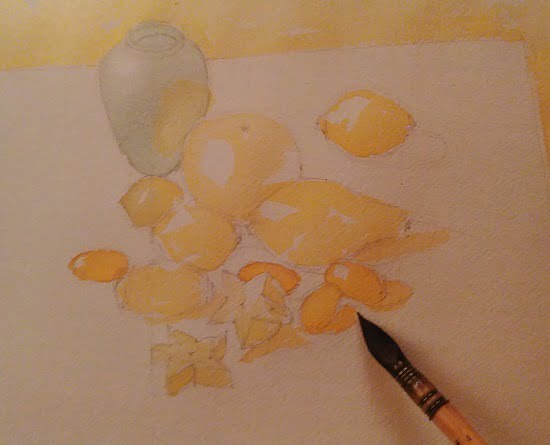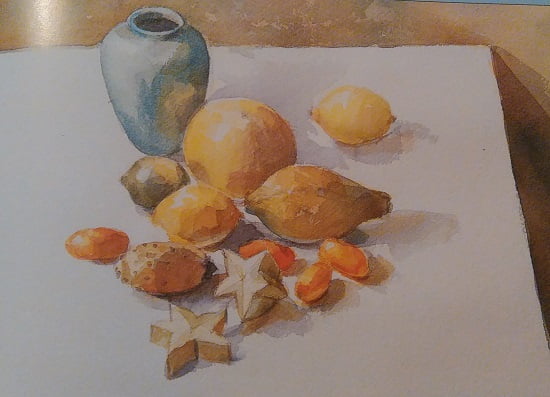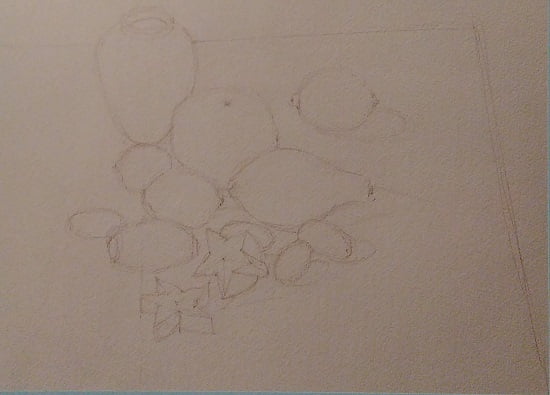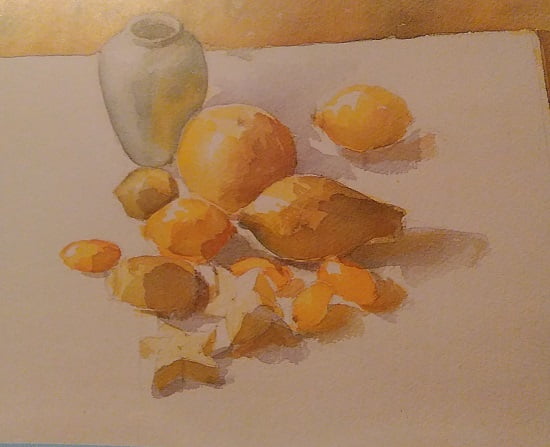Gum Arabic is gained from the tropical almond raisin and it has been used as a binder in the production of watercolors for centuries. You can also purchase it as bottled liquid and use it as a painting medium. When added to watercolors it enrichens the texture and enhances the liveliness of the colors.
Below I will give you one example on how to use gum arabic in watercolor painting. Gum arabic slows down the drying period of the paint and that allows you to work with the paint longer and create new textural effects.
Paint mixed with gum arabic can be easily rewetted and removed from the paper if needed since gum arabic binds the pigments and stops it sinking in the paper.
Be careful about the amount of gum arabic you are adding to your paint since too much of it can cause the color to become unstable and all gelatine like. Best would be to add a bit of it to the water you are using to dilute your paints but you can also add a small drop to the paint already diluted on your palette.
You can also use gum arabic as a sort of varnish. When the compleated painting is fully dry you can use gum arabic diluted with water and go over your painting using a wide brush.
That will give the painting a nice shiny finish. Never use undiluted gum arabic though since it can crack over time.

Watercolor Painting Of Topical Fruit
On this painting, layers of color are added one on top of the other in a manner to depict the shape of the fruit. Adding the gum arabic and ox gall to the paint gave it a new dimension and the possibility to develop texture and tone.
In order to paint this you will need:
- One sheet of rough watercolor paper
- Ox gall
- Gum arabic
- Medium-sized round brush
- Round brush number 4
- HB pencil
You will also need the following colors:
- Cobalt Blue
- Prussian Blue
- Morning Yellow
- Reddish pink
- Chinese White
Sketching
Sketch the main contour of the composition using an HB pencil but at this phase do not add any details to your sketch. Check that all the objects are placed in proportion to each other and that are positioned well on the paper.
Cover the space in the background using a pale spread of Morning Yellow. Paint with big relaxed moves using a medium-sized round brush. Add a smear of the same paint to the vase to depict the reflection of grapefruit on its shiny surface.
Paint all the fruit with the same color leaving small white areas of uncovered paper here and there for the brightest areas on them. For the smallest fruit ad a little bit of Reddish pink to the paint in order to gain pale orange.
To paint the vase use a mixture of heavy diluted Prussian Blue and Cobalt Blue. Leave a bit of the vase unpainted for the brightest area on it.
Adding The Details
When the first layer of paint is dried start building round shapes of the vase and fruit using darker tones. Add thin spreads of Cobalt Blue mixed with Morning Yellow to grapefruit, lemon, lime, Indian fig and fruit stars to give them greenish tones focusing on the shaded areas of the fruits.
Slightly add the same color to the background and then paint the shadows behind the fruit. Ad warmer tones to the fruit using different mixtures of Morning Yellow, red and a bit of cobalt blue painting layer over layer in the shadows to depict the tridimensionality of the objects.
Use a medium-sized brush to add a small amount of ox gall over the background area and then add some of the same warm colors you already mixed and let them blend wet on wet with previously painted layers. That will even up your painting connecting the front plane and the background. With round brush number 4 darken the shadows using Prussian Blue and Cobalt Blue.
Gradually add more pigment to basic layers also add darker tones to create a variety of tone and depict the light that shines on the objects on the sides. Notice the reflections of the objects on each other. Reflection of grapefruit on the vase or subtle nuance of yellow in some of the shadows.
Focus on the shadows building transparent layers of color one on top of the other. Mix a bit of gum arabic with the paint for the darkest tones. That will add thickness to the paint allowing you to add it with different brush strokes thus creating form and texture.
Gum arabic also gives depth and shine to the darkest tones preventing them from blurring. Leave it to dry and then use a mixture of grey shadow to depict the knotty texture of Indian fig.
Finishing Touches
Develop dark and medium tones that depict the round form of the vase using transparent layers of Cobalt Blue and Prussian Blue adding Morning Yellow for greenish tones.
Add a bit of reddish-pink to the mixture and also ad a bit of gum arabic to make it thicker and easier to control when you are painting the details. Use the mixture to strengthen small areas of deep shadows where the objects are close to each other.
Mix a strong mixture of red and yellow to add color to warm shadows on small fruit. To finish the painting use a little bit of Chinese White on certain areas of the objects creating the impression of reflections of light. At this stage, you can also use white to correct any area on the painting that you think that needs to be corrected.
Step away from your painting to make sure you got the right perspective and that objects in the back are ostensibly in the distance. You might need to add warmer nuance to the objects in the front plane so they stand out.
If you need any help or have any questions regarding the subject feel free to leave them in the comment section and I will be more than happy to help. Enjoy painting!








0 Comments